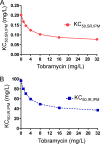Evaluation of Pharmacokinetic/Pharmacodynamic Model-Based Optimized Combination Regimens against Multidrug-Resistant Pseudomonas aeruginosa in a Murine Thigh Infection Model by Using Humanized Dosing Schemes
- PMID: 28993331
- PMCID: PMC5700304
- DOI: 10.1128/AAC.01268-17
Evaluation of Pharmacokinetic/Pharmacodynamic Model-Based Optimized Combination Regimens against Multidrug-Resistant Pseudomonas aeruginosa in a Murine Thigh Infection Model by Using Humanized Dosing Schemes
Abstract
We previously optimized imipenem and tobramycin combination regimens against a double-resistant clinical Pseudomonas aeruginosa isolate by using in vitro infection models, mechanism-based pharmacokinetic/pharmacodynamic modeling (MBM), and Monte Carlo simulations. The current study aimed to evaluate these regimens in a neutropenic murine thigh infection model and to characterize the time course of bacterial killing and regrowth via MBM. We studied monotherapies and combinations of imipenem with tobramycin in vivo against the double-resistant clinical P. aeruginosa isolate by using humanized dosing schemes. Viable count profiles of total and resistant populations were quantified over 24 h. Tobramycin monotherapy (7 mg/kg every 24 h [q24h] as a 0.5-h infusion) was ineffective. Imipenem monotherapies (continuous infusion of 4 or 5 g/day with a 1-g loading dose) yielded 2.47 or 2.57 log10 CFU/thigh killing at 6 h. At 24 h, imipenem at 4 g/day led to regrowth up to the initial inoculum (4.79 ± 0.26 log10 CFU/thigh), whereas imipenem at 5 g/day displayed 1.75 log10 killing versus the initial inoculum. The combinations (i.e., imipenem at 4 or 5 g/day plus tobramycin) provided a clear benefit, with bacterial killing of ≥2.51 or ≥1.50 log10 CFU/thigh compared to the respective most active monotherapy at 24 h. No colonies were detected on 3×MIC agar plates for combinations, whereas increased resistance (at 3×MIC) emerged for monotherapies (except imipenem at 5 g/day). MBM suggested that tobramycin considerably enhanced the imipenem target site concentration up to 2.6-fold. The combination regimens, rationally optimized via a translational modeling approach, demonstrated substantially enhanced bacterial killing and suppression of regrowth in vivo against a double-resistant isolate and are therefore promising for future clinical evaluation.
Keywords: imipenem; mathematical modeling; neutropenic thigh infection model; population pharmacokinetics and pharmacodynamics; tobramycin.
Copyright © 2017 American Society for Microbiology.
Figures




Similar articles
-
Optimization of Synergistic Combination Regimens against Carbapenem- and Aminoglycoside-Resistant Clinical Pseudomonas aeruginosa Isolates via Mechanism-Based Pharmacokinetic/Pharmacodynamic Modeling.Antimicrob Agents Chemother. 2016 Dec 27;61(1):e01011-16. doi: 10.1128/AAC.01011-16. Print 2017 Jan. Antimicrob Agents Chemother. 2016. PMID: 27821448 Free PMC article.
-
Aminoglycoside Concentrations Required for Synergy with Carbapenems against Pseudomonas aeruginosa Determined via Mechanistic Studies and Modeling.Antimicrob Agents Chemother. 2017 Nov 22;61(12):e00722-17. doi: 10.1128/AAC.00722-17. Print 2017 Dec. Antimicrob Agents Chemother. 2017. PMID: 28893782 Free PMC article.
-
Optimization and Evaluation of Piperacillin-Tobramycin Combination Dosage Regimens against Pseudomonas aeruginosa for Patients with Altered Pharmacokinetics via the Hollow-Fiber Infection Model and Mechanism-Based Modeling.Antimicrob Agents Chemother. 2018 Apr 26;62(5):e00078-18. doi: 10.1128/AAC.00078-18. Print 2018 May. Antimicrob Agents Chemother. 2018. PMID: 29463528 Free PMC article.
-
Left-sided endocarditis caused by Pseudomonas aeruginosa: successful treatment with meropenem and tobramycin.Diagn Microbiol Infect Dis. 2003 Oct;47(2):427-30. doi: 10.1016/s0732-8893(03)00135-4. Diagn Microbiol Infect Dis. 2003. PMID: 14522517 Review.
-
Semi-mechanistic pharmacokinetic-pharmacodynamic modelling of antibiotic drug combinations.Clin Microbiol Infect. 2018 Jul;24(7):697-706. doi: 10.1016/j.cmi.2017.11.023. Epub 2017 Dec 8. Clin Microbiol Infect. 2018. PMID: 29229429 Review.
Cited by
-
Combating Multidrug-Resistant Bacteria by Integrating a Novel Target Site Penetration and Receptor Binding Assay Platform Into Translational Modeling.Clin Pharmacol Ther. 2021 Apr;109(4):1000-1020. doi: 10.1002/cpt.2205. Epub 2021 Mar 24. Clin Pharmacol Ther. 2021. PMID: 33576025 Free PMC article.
-
Losing the Battle but Winning the War: Can Defeated Antibacterials Form Alliances to Combat Drug-Resistant Pathogens?Antibiotics (Basel). 2021 May 28;10(6):646. doi: 10.3390/antibiotics10060646. Antibiotics (Basel). 2021. PMID: 34071451 Free PMC article. Review.
-
Proof-of-concept for incorporating mechanistic insights from multi-omics analyses of polymyxin B in combination with chloramphenicol against Klebsiella pneumoniae.CPT Pharmacometrics Syst Pharmacol. 2023 Mar;12(3):387-400. doi: 10.1002/psp4.12923. Epub 2023 Feb 1. CPT Pharmacometrics Syst Pharmacol. 2023. PMID: 36661181 Free PMC article.
-
Epidemiology and Treatment of Multidrug-Resistant and Extensively Drug-Resistant Pseudomonas aeruginosa Infections.Clin Microbiol Rev. 2019 Aug 28;32(4):e00031-19. doi: 10.1128/CMR.00031-19. Print 2019 Sep 18. Clin Microbiol Rev. 2019. PMID: 31462403 Free PMC article. Review.
-
Analysis of the Distribution and Antibiotic Resistance of Pathogens Causing Infections in Hospitals from 2017 to 2019.Evid Based Complement Alternat Med. 2022 Sep 16;2022:3512582. doi: 10.1155/2022/3512582. eCollection 2022. Evid Based Complement Alternat Med. 2022. PMID: 36159558 Free PMC article.
References
-
- Boucher HW, Talbot GH, Benjamin DK Jr, Bradley J, Guidos RJ, Jones RN, Murray BE, Bonomo RA, Gilbert D. 2013. 10 × '20 progress–development of new drugs active against Gram-negative bacilli: an update from the Infectious Diseases Society of America. Clin Infect Dis 56:1685–1694. doi:10.1093/cid/cit152. - DOI - PMC - PubMed
-
- Infectious Diseases Society of America (IDSA), Spellberg B, Blaser M, Guidos RJ, Boucher HW, Bradley JS, Eisenstein BI, Gerding D, Lynfield R, Reller LB, Rex J, Schwartz D, Septimus E, Tenover FC, Gilbert DN. 2011. Combating antimicrobial resistance: policy recommendations to save lives. Clin Infect Dis 52(Suppl 5):S397–S428. doi:10.1093/cid/cir153. - DOI - PMC - PubMed
MeSH terms
Substances
LinkOut - more resources
Full Text Sources
Other Literature Sources
Medical

